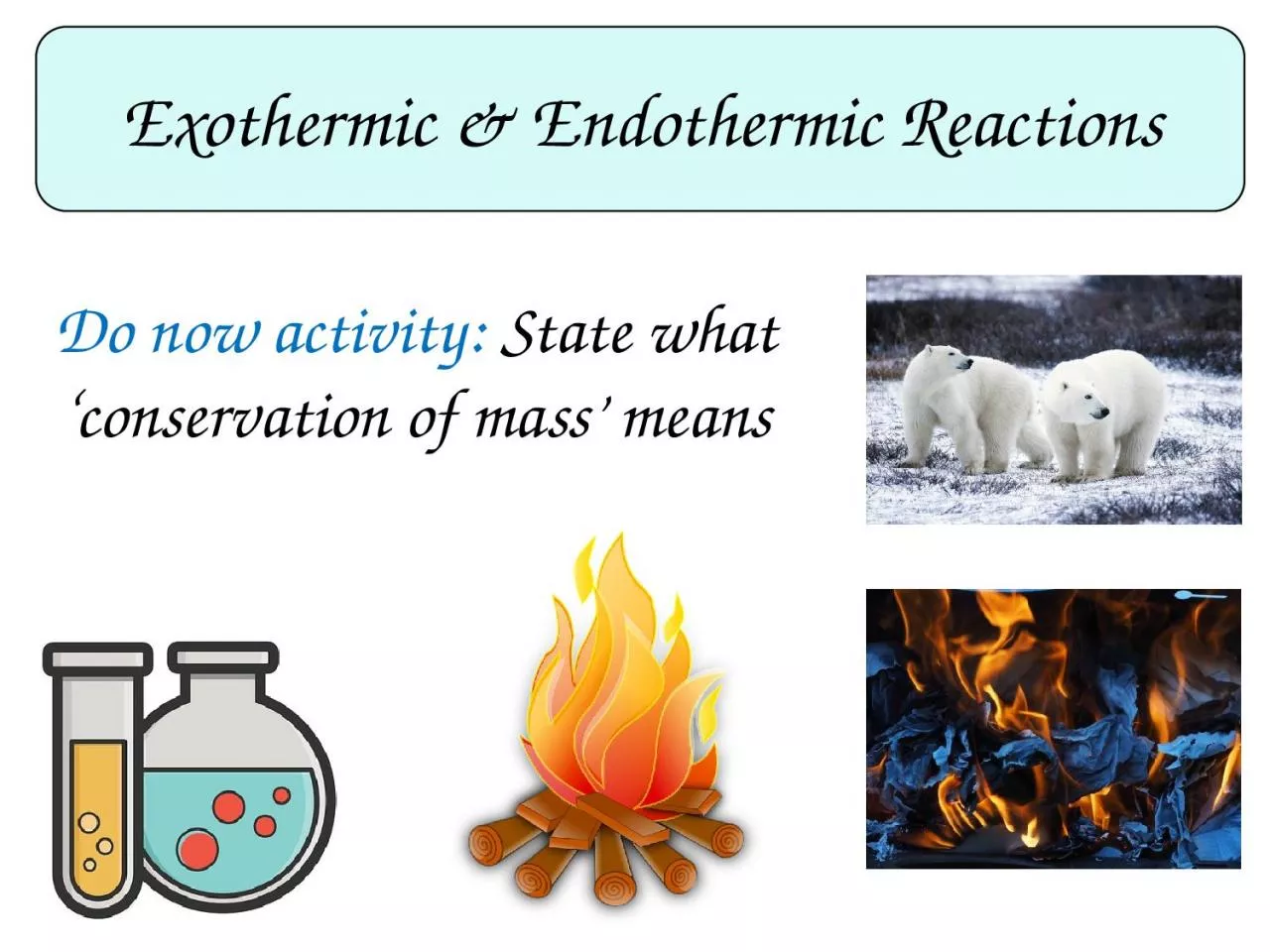

Do now activity State what conservation of mass means GOOD PROGRESS Define the terms endothermic and exothermic Give some examples of endothermic and exothermic reactions OUTSTANDING PROGRESS ID: 1047100
Download Presentation The PPT/PDF document "Exothermic & Endothermic Reactions" is the property of its rightful owner. Permission is granted to download and print the materials on this web site for personal, non-commercial use only, and to display it on your personal computer provided you do not modify the materials and that you retain all copyright notices contained in the materials. By downloading content from our website, you accept the terms of this agreement.
1. Exothermic & Endothermic ReactionsDo now activity: State what ‘conservation of mass’ means
2. GOOD PROGRESS:Define the terms endothermic and exothermicGive some examples of endothermic and exothermic reactionsOUTSTANDING PROGRESS:Describe the characteristics of exothermic and endothermic changesProgress indicators
3. There are plenty of examples of exothermic reactions, this is a reaction where energy is transferred from the reacting chemicals to the environment.https://www.youtube.com/watch?v=CWMATrOatRwThe thermite reactionThe screaming jelly babyhttps://www.youtube.com/watch?v=410b79CPqP0CombustionRustingNeutralisation
4. So what do you think might happen during an ‘endothermic’ reaction?Think > Pair > Share: Discuss your ideas for a definition of an ‘endothermic’ reaction and come up with any examples if you can!An endothermic reaction is one where energy is transferred from the environment to the reacting chemicals. Thermal decomposition of calcium carbonateSherbet dissolving in water
5. https://www.youtube.com/watch?v=eJXL0IrbtqETask: Watch the video and answer the following questions:What is an endothermic reaction?What is an exothermic reaction?Name three examples of exothermic reactions.How could you detect an exothermic reaction?What are three examples of an endothermic reaction?
6. Self-assessment:An endothermic reaction is a reaction which takes energy in from the surroundingsAn exothermic reaction is a reaction which transfers energy to the surroundings.Neutralisation reaction between an acid and an alkali, reaction between water and calcium oxide and respiration.You can detect an exothermic reaction by using a thermometer, if the temperature increases during a reaction it is exothermic.Electrolysis, the reaction between sodium carbonate and ethanoic acid and photosynthesis.
7. Investigate: Endothermic or exothermic reaction?Task: In pairs you will carry out an investigation to identify whether a reaction is endothermic or exothermic.Copy the following table into your books in order to record your results:ExperimentTemperature at the start (⁰C)Temperature at the end (⁰C)Change in temperature (⁰C)Other observationsEndothermic or exothermic reaction?123Important: Wear eye protection at all times!!
8. Quick CheckQ. The table shows the temperature changes that occur when some substances dissolve in water. Which of these substances dissolves exothermically? Explain your choices.Name of substanceTemperature before (°C)Temperature after (°C)Potassium chloride2012Calcium chloride2042Sodium hydrogen carbonate2018Sodium carbonate2023
9. Self-assessment:A: Calcium chloride and sodium carbonate both dissolve in water exothermically. We can tell this from the results as once these two substances are placed in water the temperature increases, this causes energy to be transferred to the surroundings indicating an exothermic reaction.
10. Plenary: Anagram challenge:Task: Unscramble the following words to reveal 6 key words from the lesson today:mroetiednhctacneivrosonsmsa reoetmxihcitrcoeanlcacmehiExtra Challenge: Come up with a definition for each of the words once you have unscrambled them!EndothermicConservation Mass Exothermic ReactionChemical
11. Resources
12. Endothermic or exothermic?Equipment needed:anhydrous copper(II) sulfate • citric acid • sodium hydrogencarbonate • copper(II) sulfate solution • zinc powder • test tubes • spatula • dropping pipette • measuring cylinder • glass stirring rod MethodExperiment 1: A test for waterPut a spatula measure of white, anhydrous copper(II) sulfate powder into a test tube.Use a dropping pipette to add a few drops of water to the powder.Watch what happens and cautiously feel the bottom of the tube.Experiment 2: A sherbet mixtureIn a dry test tube, mix one spatula measure of citric acid with one spatula measure of sodium hydrogen carbonate. Add about 2 cm3 water to the mixture. Watch what happens and cautiously feel the bottom of the tube.Experiment 3: A competition reactionPut about 5 cm3 copper(II) sulfate solution in a test tube.Using a spatula, add a small measure of powdered zinc. Stir with a glass rod. Watch what happens and cautiously feel the bottom of the tube.Endothermic or exothermic?Equipment needed:anhydrous copper(II) sulfate • citric acid • sodium hydrogencarbonate • copper(II) sulfate solution • zinc powder • test tubes • spatula • dropping pipette • measuring cylinder • glass stirring rod MethodExperiment 1: A test for waterPut a spatula measure of white, anhydrous copper(II) sulfate powder into a test tube.Use a dropping pipette to add a few drops of water to the powder.Watch what happens and cautiously feel the bottom of the tube.Experiment 2: A sherbet mixtureIn a dry test tube, mix one spatula measure of citric acid with one spatula measure of sodium hydrogen carbonate. Add about 2 cm3 water to the mixture. Watch what happens and cautiously feel the bottom of the tube.Experiment 3: A competition reactionPut about 5 cm3 copper(II) sulfate solution in a test tube.Using a spatula, add a small measure of powdered zinc. Stir with a glass rod. Watch what happens and cautiously feel the bottom of the tube.Important: Wear eye protection at all times!!Important: Wear eye protection at all times!!